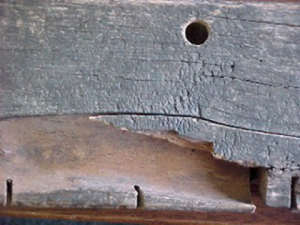There are two types of carpenter bees that can be found within the United States. The large carpenter bees (Xylocopa) and small carpenter bees (Ceratina). The common name “carpenter bee” derives from their nesting behavior; nearly all species burrow into hard plant material such as dead wood or bamboo. The large carpenter bees are the ones mostly responsible for damages known to property owners.
What do they look like?

The main difference between the two are their sizes. Large carpenter bees range from being 12-25 mm long while small ones are less than 8 mm long. Xylocopa don’t have hair so they look somewhat glossy, while Ceratina are darker in color and look metallic.
Both of them can have some yellow markings on their body and face that make them look like bumblebees.
Also, they leave yellowish combinations of pollen and excrement near their shelters. These species are among the most complex in shape of any group of bees; whereas most bees fill their brood cells with a soupy mass and others form simple pollen masses, Xylocopa species form elongated and carefully sculpted masses that have several projections which keep the bulk of the mass from coming into contact with the cell walls.
The eggs are very large relative to the size of the female, and are some of the largest eggs among all insects.
Two very different mating systems that appear to be common in carpenter bees, and often this can be determined by examining specimens of the males.
In the other mating system, the males often have very small heads, but a large, hypertrophied glandular reservoir is in the mesosoma, which releases pheromones into the airstream behind the male while it flies or hovers.
How do they affect us?

doyourownpestcontrol.com
Aside from stinging you, carpenter bees are also capable of damaging your wooden structures. These bees don’t actually eat wood, but they do excavate them if they need shelter or chambers to rear their young.
They particularly prefer wood that is dry, unpainted, or weathered down. Examples of structures that can interest carpenter bees are doors, window sills, railings, decks, and lawn furniture.
If you see nearly perfectly round holes (approximately ½ inch in diameter) on your wooden structures, then carpenter bees can be one of the culprits. These drillings can leave piles of sawdust around the structure, which can be a nuisance to clean up after.
How do I manage them?

pestkill.org
Check the infested wood and apply insecticide into the holes. To avoid possible stings, apply the insecticides at night as bees are still asleep.
Also, it’s advisable to wear protective clothing that fully covers your skin. Do not plug the holes immediately! The bees should be able to pass freely through the nest entrance where they will contact the dust and distribute it inside the tunnels.
Also any new matured bees will emerge through the openings and contact the dust placed there. It is a good idea to treat in the spring, again in mid-summer to kill any bees which may not have acquired a sufficient treatment when they emerged, and a third time in early fall to contact any over-wintering bees occupying the tunnels. In the fall, the holes should be filled with wood putty or wooden dowels and the entire wood surface painted or varnished. Stained wood is not usually protected from attack.
Handling bees can be dangerous because they are highly aggressive once provoked. There are also risks in handling pesticides, so leave it to a pest professional for a more efficient and safe treatment.

Recent Comments